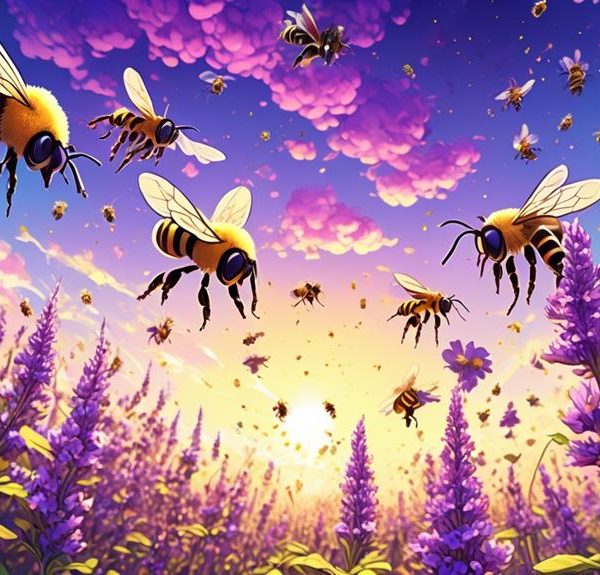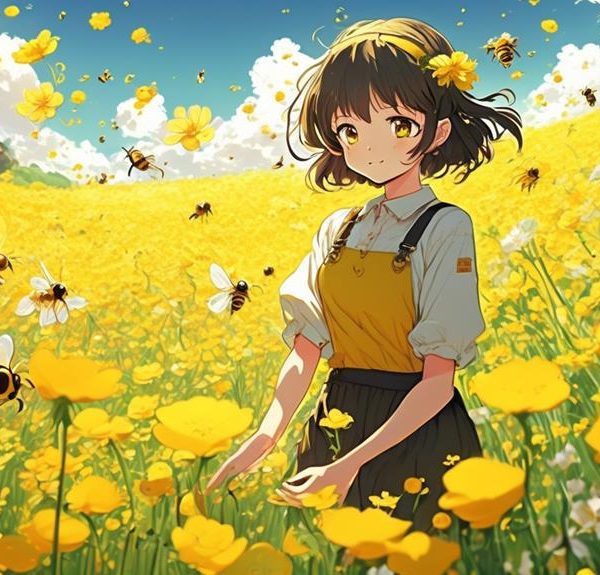Navigate the intriguing relationship between bees and burdock root, a plant with an unexpected appeal to the buzzing pollinators.
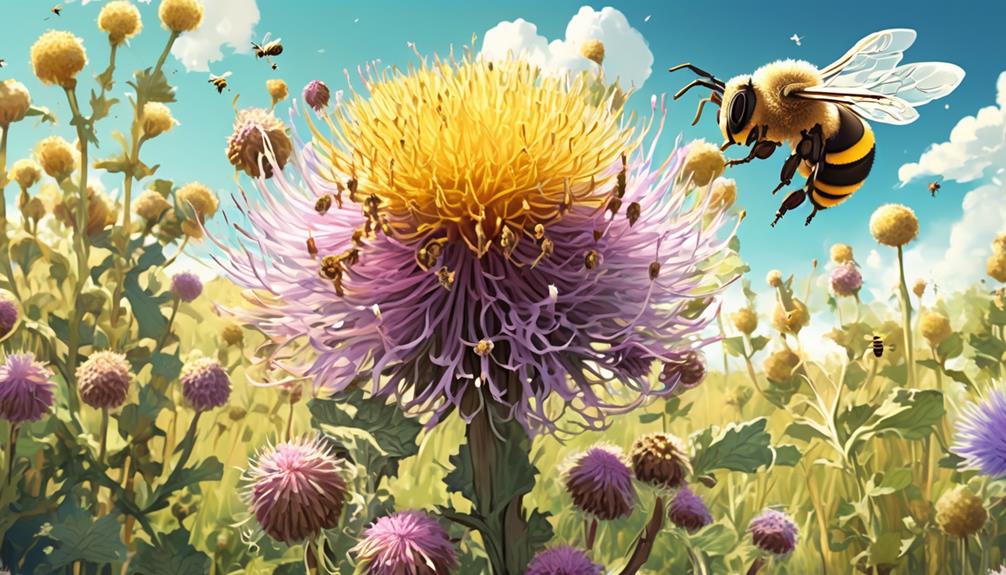
Do Bees Like Burdock Root
Like a detective piecing together a complex case, you've likely noticed the intricate dance between bees and the plants in your garden.
The question that may be buzzing around in your mind now is: do bees have a particular interest in burdock root?
This peculiar plant, with its rough exterior and a core filled with health benefits, is common in many gardens.
But does it hold the same appeal for our buzzing friends as it does for us? Well, that's a fascinating question we're about to explore.
Are you ready to dive into the buzzworthy world of bees and burdock?
Key Takeaways
- Bees are attracted to burdock plants during the flowering season due to their vibrant purple flowers and scent.
- Burdock root provides bees with nectar and essential nutrients, supporting their nutrition and reproduction.
- Burdock root has therapeutic properties recognized in traditional medicine, including detoxifying effects and blood purification.
- Integrating burdock plants in gardens can support local bee populations and provide potential health benefits for humans.
Understanding the Bee's Diet
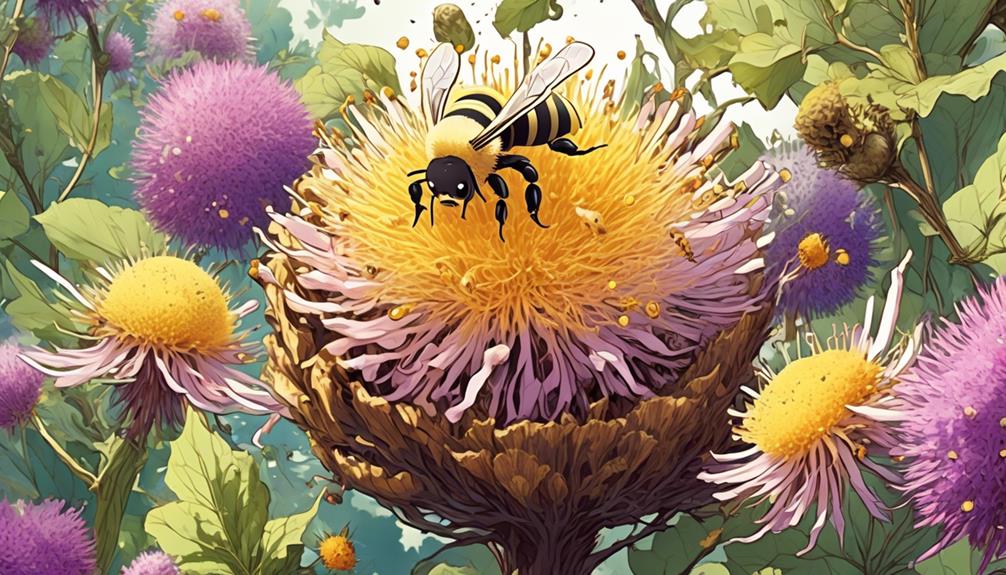
To fully grasp the dietary habits of bees, you need to delve into the intricate world of these buzzing creatures, noting that they chiefly subsist on nectar and pollen, but their consumption can also extend to other plant substances, such as the medicinal burdock root.
Here's a closer look: Bees' primary food source is nectar, a sugary liquid that they extract from flowers. This nectar provides them with the necessary carbohydrates to fuel their high-energy lifestyle. They also collect pollen, a protein-packed substance critical for the nutrition of their larvae.
However, their diet's diversity doesn't stop there. Bees have been observed feeding on other plant substances, such as the sap of trees, and occasionally, the juicy sweetness of ripe fruits. One such plant substance they've been known to consume is the burdock root.
Burdock root is a medicinal plant known for its detoxifying properties in traditional herbal medicine. It's speculated that bees might ingest the root for its medicinal benefits, perhaps to ward off diseases or parasites. However, scientific studies are needed to confirm this theory.
Understanding this aspect of their diet could provide valuable insights into the health and survival strategies of these vital pollinators.
The Alluring Burdock Root
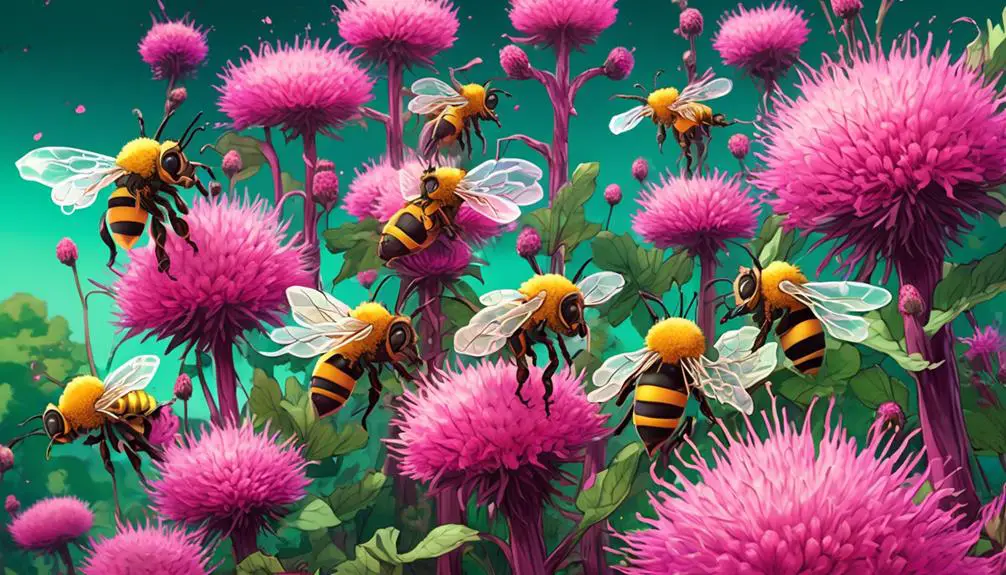
Shifting our focus to the burdock root, it's important you understand its unique allure, not only to bees but also within the broader context of natural and traditional medicine. This biennial plant, scientifically known as Arctium lappa, is native to Europe and Asia but is now extensively cultivated globally.
Burdock root's appeal to bees primarily lies in its flowers. The plant's purple, thistle-like blooms are rich in nectar, attracting bees and other pollinators. These blossoms are a food source for bees, providing essential nutrients and carbohydrates.
Simultaneously, burdock root boasts significant therapeutic properties that have been recognized for centuries in traditional medicine. It's known for its detoxifying effects, believed to purify the blood and cleanse the lymphatic system. It's also appreciated for its antioxidant and anti-inflammatory attributes, contributing to its potential in managing an array of health conditions.
In terms of chemical constituents, burdock root contains inulin, a type of dietary fiber beneficial for gut health. It also houses phenolic acids, quercetin, and luteolin – potent antioxidants that promote overall health.
Bees and Burdock: A Possible Connection
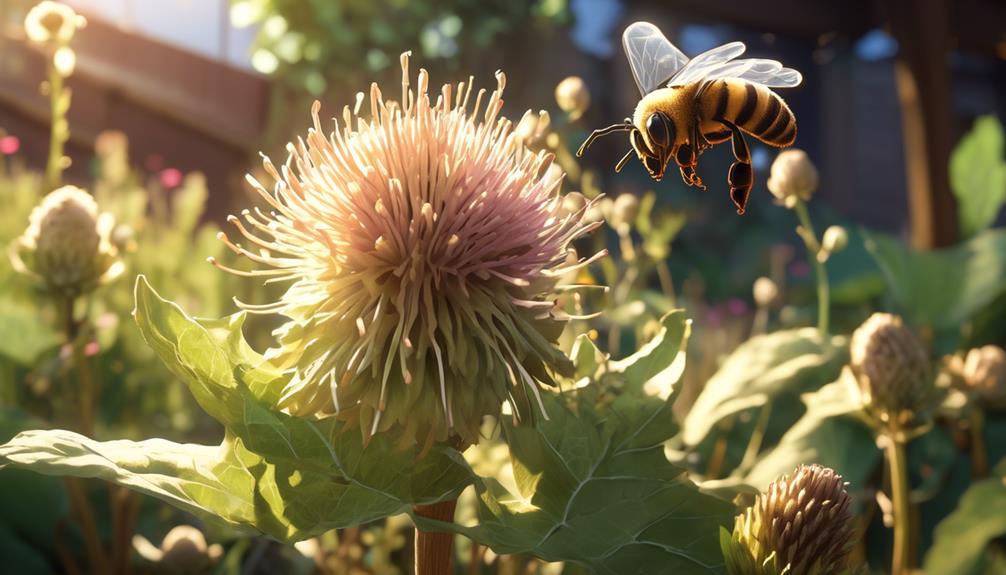
Now, let's delve into the intriguing relationship between bees and burdock root, exploring possible connections that may hold significant implications for both bee health and natural medicine. Studies have suggested that bees are attracted to the burdock plant, particularly during flowering season. It's thought that the plant's vibrant purple flowers and distinct scent may lure bees, offering a rich source of nectar and pollen.
Consider the following table outlining key aspects of this relationship:
Aspect | Bees | Burdock |
|---|---|---|
Attraction | High | Purple Flowers, Scent |
Benefit | Nectar, Pollen | Pollination |
Implication | Enhanced Foraging | Increased Reproduction |
This connection isn't just fascinating—it's potentially beneficial. If bees are indeed attracted to burdock, this plant could be strategically used to support bee populations, which have been declining worldwide. On the flip side, bees play a crucial role in the reproduction of burdock plants through pollination. In terms of natural medicine, burdock root has been linked to numerous health benefits, and bees could help increase its production.
While more research is needed, it's clear that the relationship between bees and burdock root could have far-reaching implications.
Implications for Your Garden
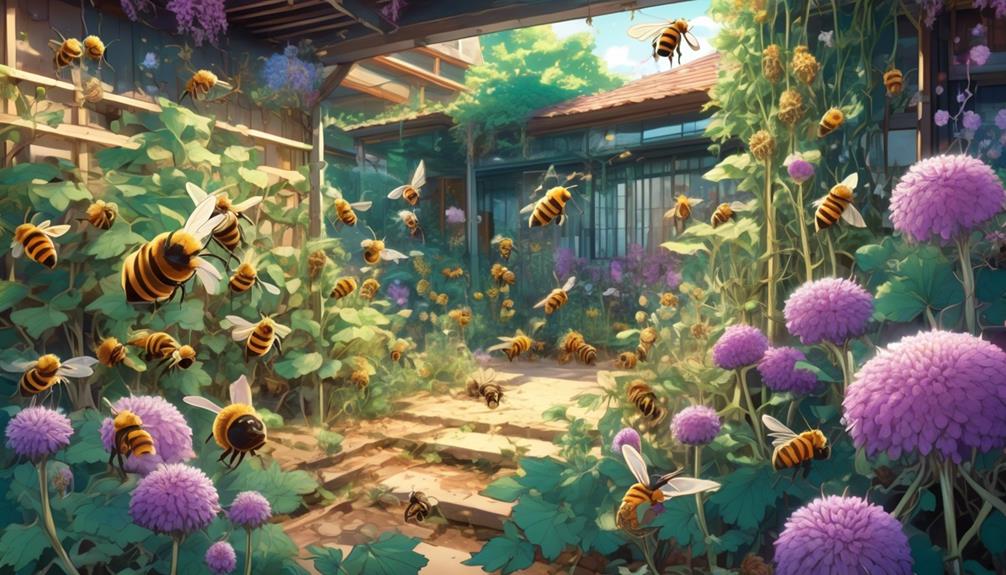
Integrating burdock plants into your garden could potentially support local bee populations while enhancing the natural biodiversity of your home ecosystem. Burdock, a hardy biennial, thrives in most soil types, making it an easily adaptable addition to any garden.
The plant's root, rich in inulin, a form of natural sugar, may attract bees due to its high energy content. This could contribute to increased bee activity in your garden, potentially improving pollination rates for other plants.
However, it's important to consider the potential drawbacks. Burdock can grow quite large, often up to four feet in height, which could overshadow smaller plants. It's also a prolific self-seeder, which could lead to it dominating your garden if unchecked.
Moreover, burdock's spiky burrs may cause discomfort for pets and children. Therefore, strategic placement is critical – perhaps at the back of a border or within a wildlife-friendly section.
Enhancing Bee-Friendly Spaces
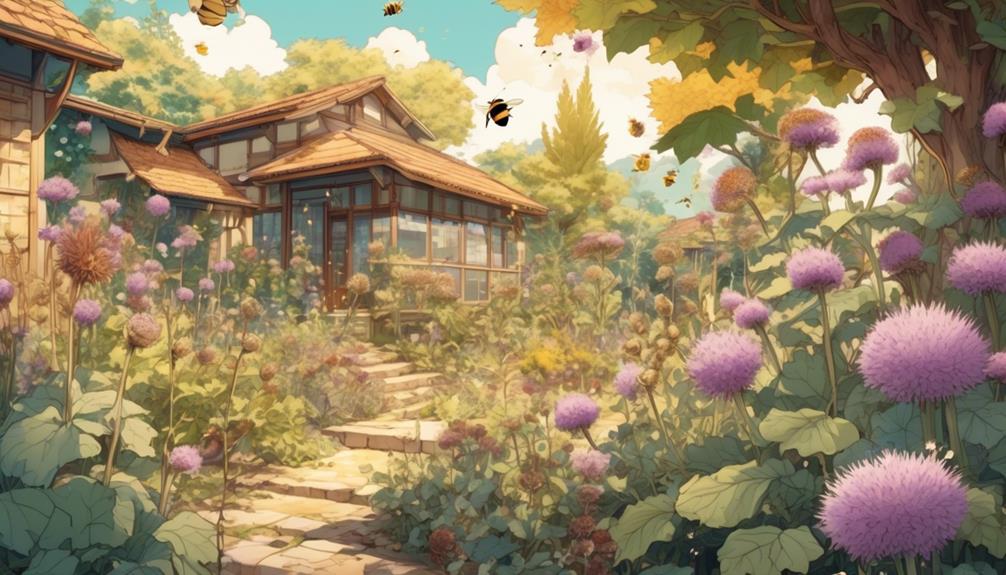
To enhance bee-friendly spaces in your garden, you'll need to strategically incorporate a variety of flowering plants, like burdock, that provide ample nectar and pollen throughout different seasons. Consider the growth pattern and flowering time of each plant to ensure a steady stream of resources for your local bees.
Burdock root, for instance, is an excellent choice for this purpose. Its flowers, which bloom from July to October, provide bees with vital nectar during a period when many other plants have finished flowering. Moreover, the burdock's large, umbrella-shaped flower heads are easily accessible to bees, aiding their foraging efforts.
But remember, it's not just about one plant. Creating a bee-friendly space requires a range of flowering plants of different types and flowering times. Consider incorporating plants like lavender, which flowers early in the season, and goldenrod, which blooms late. This ensures a continuous supply of nectar and pollen for bees.
Lastly, avoid using pesticides. These can have detrimental effects on bee populations. Instead, opt for organic gardening practices. By doing so, you're not only enhancing a bee-friendly space but also contributing to a healthier, more sustainable ecosystem.
Frequently Asked Questions
How Does the Climate Affect Burdock Root Growth and Does This Have an Impact on Bees' Attraction to It?
Climate greatly affects burdock root growth. In colder weather, it's more robust, attracting bees with its vibrant flowers. In hotter climates, it struggles, producing fewer flowers, which could decrease its appeal to bees.
Are There Any Other Insects That Are Attracted to Burdock Root, Besides Bees?
Sure, aside from bees, other insects are also attracted to burdock root. For example, butterflies and moths often visit burdock for its nectar.
Additionally, certain types of beetles and flies can be found around these plants.
Remember, the diversity of insects on burdock root can vary based on factors like location and season.
It's a fascinating ecosystem to observe if you're interested in entomology.
Can the Consumption of Burdock Root Have Any Negative Effects on Bees?
You're wondering if consumption of burdock root might harm bees.
Currently, there's no scientific evidence suggesting that burdock root has any negative effects on bees. Bees are attracted to this plant for its nectar and pollen. They can digest these substances without harm.
Always remember, plants and bees have co-evolved and typically, what's good for the plant is also good for the bee.
Do Bees Prefer Burdock Root Over Other Types of Plants?
You're inquiring if bees have a preference for burdock root over other plants.
While bees are known to pollinate a wide variety of plants, there's no definitive research suggesting they favor burdock root specifically.
They're attracted to plants with high nectar and pollen content, which does include burdock.
However, it's not clear if they prefer it over others.
More research would be needed to confidently answer your question.
Are There Specific Species of Bees That Are More Attracted to Burdock Root Than Others?
You're asking if certain bee species are more drawn to burdock root.
It's not exactly clear-cut. While many bee species visit burdock for its nectar, there's no definitive research that shows a specific species favoring burdock over other plants.
It's more about what's available and abundant in their habitat. However, honeybees and bumblebees are often seen around burdock, but it's not exclusive. They're generalists, meaning they'll visit a variety of plants for food.
Conclusion
In summary, while bees don't specifically seek out burdock root, they're attracted to its flowers, rich in nectar. You, as a garden enthusiast, can leverage this to create bee-friendly spaces.
An ecosystem with burdock could encourage a healthy bee population. Therefore, understanding bee dietary preferences and incorporating plants like burdock can indeed lead to a more harmonious, biodiverse garden.
Keep exploring, keep observing, your garden's potential is limitless!

